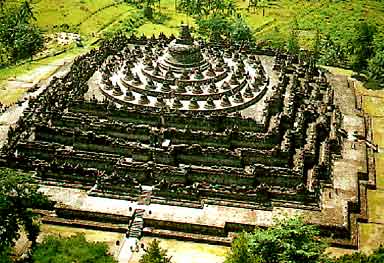
An Introduction

For hundreds of years, the Buddhist sactuary of "Borobudur" has existed unnoticed, overgrown in the tropical climate of Central Java. The monument was ordered to be constructed around 750 A.D. by a powerful and wealthy ruler of the Cailendra Dynasty.
The meaning of the name "Borobudur" remains unexplained but might be a modification of two words from Sanskrit - "Complex of Temples on the Hill". A second explanation is offered by an inscription dating back to the years 842 A.D., according to which the word "Borobudur" would mean "Accumulation of Virtue in the Ten Stages of the Bodhisattvas".
Almost one thousand years later, a Javanese nobleman took the first step towrds the temple's rediscovery and was soon folowed by Sir Stamford Raffles, the British Governor General at that time.The enormous dimensions as well as very differentiated symbolism have made Borobudur one of the largest temple contruction outside India. On account of its technical, architectonicand symbolic structure, Borobudur is closely related to other Buddhist temples in Cambodia and India.
An extensive second restoration programme with international technical and financial aid has determined the picture of the Candi Borobudur of to day. It is to be hoped that the unique character of this monument as well as the numerous still undiscovered secrets of its architecture will not be lost as rare testimony of a living past.
Borobudur
The ruler of the Buddhist Cailendra - Dynasty, had ordered at the beginning of the eight century the construction of the largest temple in the world he knew in honour of Buddha. A group of architects and priest went out to search for an area surrounded by two rivers and a mountain ridge, thus offering symbolic protection through natural protection. A suitable site was found approximately 41 kilometers north - west of Jogjakarta in today region of Magelang, Central Java. Closely related with the old ideas of ancestral worship, a sort of mountain was to be erected - a stupa made of square stone - symbol both of the unity of the cosmos and an all-embracing philosophy of the world.
Thousand of people worked under the supervision of skillied building artisans. The huge quantities of stone (approximately 55.000 m3) were supposedly taken from one source in the surrounding mountains. The estimations about exact date of the beginning of the construction as well as its termination are vary between 80 and 200 years. The numerous niches, gallery and stairways - at first seemingly boundless - are arranged in a strict and symbolic order.
At first glance, Candi Borobudur consist of nine superimposed terraces, symbol of the nine levels of the Holy Mount Meru. These terraces again differ from each other in that they belong to three spiritual phases symbolizing the levels of existence. The Buddhist religion arranges the temporal existence and the spiritual conception in three spheres. The lowest sphere - Kamadhatu - represent the transitoriness of life. Ruphadatu, the second sphere, has renounced all human desire but still takes on earthly forms. Arupadhatu, the highest and third sphere, represent Nirvana, the Unimaginable, Eternal Deliverance.
Map of Borobudur Library Contact us
© INSIST 2001